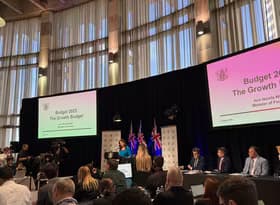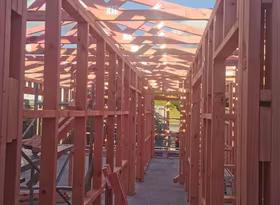
Is it time to bet on house prices rising again?
Expectations of a housing market pick-up during 2025 are mounting, with the Reserve Bank having cut the official cash rate by 125 basis points in the last four months. We look at the latest indicators to assess how much substance there might be to the market’s upturn.
Housing turnover trending higher, but still not strong
House sales have averaged 5,854 per month over the last year, which represents a steady increase in activity from its trough in the year to April 2023, when monthly sales numbers were below 4,900. Since last year’s low point, June 2024 has been the only month when sales were lower than a year earlier – a result that was affected by the timing of the Matariki public holiday.
Despite the positive annual growth, sales volumes were patchy in late 2023 and early 2024, and it has only been recently that activity has looked a bit more robust. October’s result saw seasonally adjusted sales top 6,300 for the first time since December 2021 (see Chart 1), when rising interest rates stopped the Covid housing boom in its tracks. Monthly volumes are still 3.0% below the average of the last decade – so the market is still subdued by historical standards.
That softness is reflected in other metrics. The stock of properties for sale on realestate.co.nz has been increasing since July 2023 and buyers now have the widest choice of homes to purchase since 2015. Properties took an average of 50 days (seasonally adjusted) to sell in September. As Chart 2 shows, only three months in the last 14 years have recorded a slower rate of turnover, and two of those months were affected by the 2011 Christchurch earthquake or the 2020 Covid lockdown.
Chart 3 shows that REINZ’s house price index has also fallen in six of the last eight months (seasonally adjusted) and is down 1.1% from a year ago.
Taking stock of others’ forecasts
The Reserve Bank’s house price forecasts, included in last week’s Monetary Policy Statement, attracted headlines. The Bank’s outlook predicts that house prices will rise 7.1% during 2025 and by an average of 5.3%pa over the next three years. With predicted wage growth of 3.1%pa between now and the end of 2027, the Bank’s forecasts imply a renewed deterioration in house-price-to-income ratios.
At first glance, it is somewhat alarming that the Bank’s forecasts for house prices are the strongest since the Bank started publishing its projections in their current format in 2018. However, this historical comparison also implies that the Bank’s house price forecasts are not very accurate, as demonstrated in Chart 4. The previous strongest one-year-ahead forecast by the Bank was in late 2021, for a 5.6% lift during 2022, when prices ended up falling 11%. On the other side, at the end of 2020, the Bank predicted that house prices would rise just 2.0% during 2021, drastically undershooting the eventual 27% lift.
What about other forecasters? Leaving out The Treasury, whose prediction of 1.5% growth was published way back at the Budget in May, other predictions of house price inflation during 2025 range between 6.0% and 10.9%pa. There is a general expectation that this momentum continues into the following year, with growth of 5.0%pa or over predicted across all forecasts that extend to the end of 2026.
Underpinning this expected house price growth is, of course, lower mortgage rates. Debt-servicing costs have been prohibitive for potential buyers since the Reserve Bank’s rapid tightening in monetary conditions during 2022 and 2023. As has been the case since the start of the Covid pandemic in 2020, the effects of interest rate movements have outweighed trends in net migration, resulting in a massive disconnect between population growth and house prices. The consensus view seems to be for that disconnect to continue throughout the next 1-2 years.
Lower interest rates foster more confidence
Confidence surveys around housing seem to be of limited usefulness in signalling future outcomes in the market, often having little correlation with subsequent movements in house sales or prices. Nevertheless, the biggest shift has been an 18-point lift in net positive responses to ASB’s question of whether it is a good time to buy a house, with the +20% result in the survey covering the three months to October the highest reading since mid-2020. Expectations of house price growth in both ASB’s and ANZ’s surveys have stabilised or lifted in recent months, but they remain below their long-term averages.
Is it really a good time to buy a house, as responses to ASB’s Housing Confidence survey suggest? House-price-to-income ratios still look awful for owner-occupiers. We also argued earlier this year that investors were unlikely to drive the housing market recovery, despite regulatory changes, because of negative cashflow and low rental yields. Although we still expect this conclusion about investor demand to broadly hold true, we note that growth in lending to investors has been outpacing overall mortgage lending throughout 2024. This gap has widened since mid-year (see Chart 5), with investor lending between July and October up 54% from a year ago, compared to 18% growth across all other lender types.
And perhaps the game-changer for investors has been lower mortgage rates and debt-servicing costs – dropping more sharply than the Reserve Bank had indicated earlier in the year. Referring back to ASB’s survey seems to confirm that view, with net responses about expectations for interest rates at their lowest since the survey began in 1996.
Our most recent forecasts incorporated the shift in the interest rate outlook, with an upward revision to our expectations for house price growth during 2025 from 0.9% to 5.2%pa. With the Reserve Bank signalling that it is likely to continue cutting faster than previously expected into early 2025, the risks to our forecast must still lie on the upside.
Is the labour market as much of a constraint as we thought?
The biggest remaining cloud over the outlook for housing is the labour market. All forecasters expect a further increase in the unemployment rate into 2025, from 4.8% currently to a peak of between 5.2% and 5.5%. Westpac’s survey of employment confidence also shows that people are at their most pessimistic about the labour market since the survey began in 2004.
But in a sign that households could be shrugging off the labour market weakness and responding to lower interest rates sooner than expected, core retail electronic card transactions have lifted 1.5% over the last three months. It’s hardly a rip-roaring rebound, but it is the strongest three-month result since April 2023 and marks a welcome change of trend from the 4.6% fall in the value of spending over the 15 months to July this year. Further growth in the value of spending in the short-term could also indicate even brighter prospects for the housing market in 2025.
For firms involved in the residential construction industry, the prospect of stronger house price growth next year is a welcome one. Bigger house price rises might worsen affordability for potential buyers, but they will also improve the relativity between existing and new homes and redirect buyer demand towards new builds.
Residential consent numbers have all but stabilised at between 33,000 and 34,000pa since June, with the annual total of new houses lifting 6.5% (or 967 consents) from its low point in mid-2024. Our recent discussions with businesses involved in the industry indicate that demand levels are also starting to stabilise, with enquiries and quoting activity picking up.






















